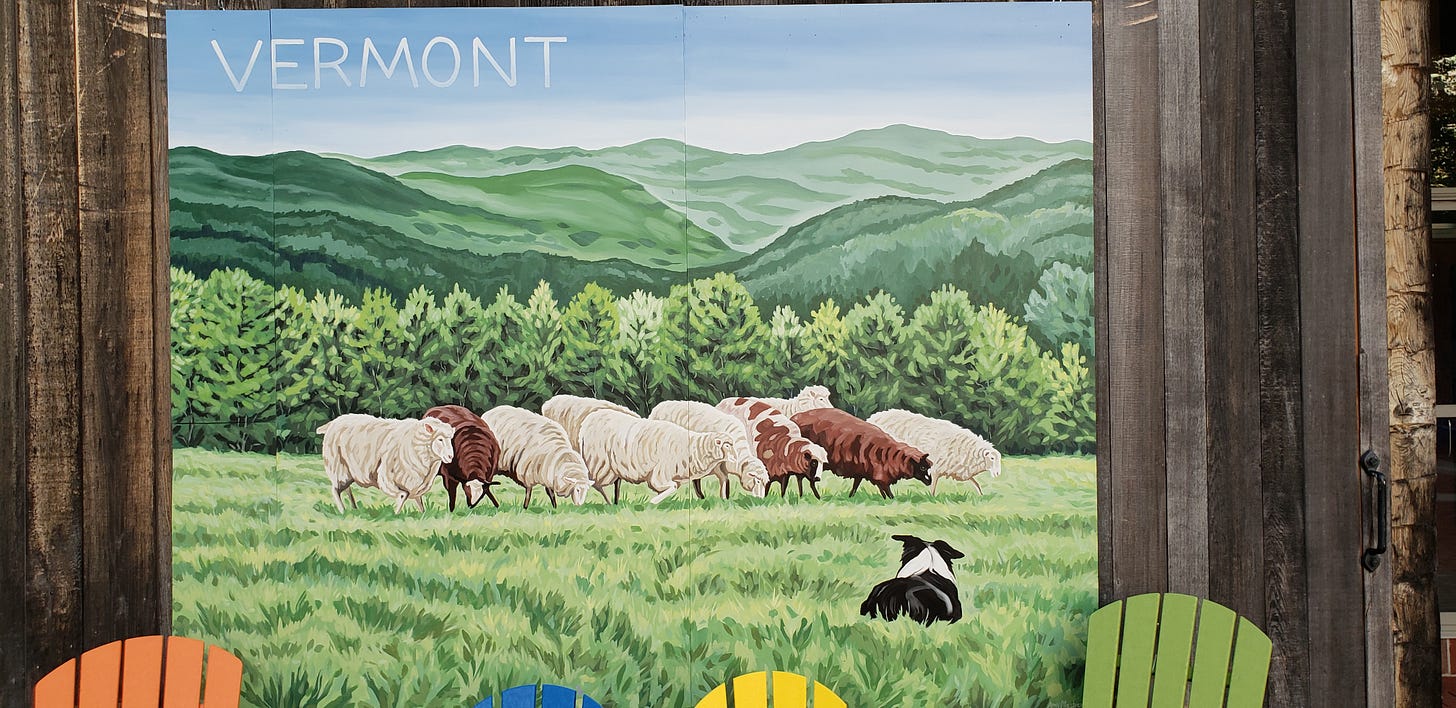(A painting at the Vermont Welcome Center in Brattleboro. There is more farm art than farming in Vermont these days. It is as if the surreal has replaced the real; idyllic sentimentality has displaced the farming culture.)
My family of numerous lineages have been farmers here in Vermont. My father’s mother grew up and worked hard on a dairy farm in Sheldon Falls. My mother grew up on the farm near where I now live — the Stoddard farm, which is one of the founding family farms here in Brookfield. My Mom’s mother, Cesarine Stoddard, was born an Alexander and raised on the Williamstown dairy farm where my cousin David Taylor still lives. Numerous family dairies — thousands, in fact — that were operating when I was a child in the 1960s are now long gone.
My great-great-great-great-grandfather, Solomon Stoddard, moved to Brookfield from New London, Connecticut, sometime around the year 1800. The family began as a sheep farm and later, like most Vermont farmers, shifted to dairy farming when the price of wool plummeted.
What sets Vermont apart from most parts of America today is that it was essentially an agrarian subsistence economy for centuries. People lived here to just get by, and live free. That’s why they came here to live. That’s why they stayed, for generations.
Increasingly, people have moved to Vermont to retire, or because they liked the scenery — but not to farm. This has changed the cultural and demographic of the state. But what has set Vermont apart is that it has held on to its agrarian culture and farmlands more than most parts of America. This is not really by choice — the state is dominated by rugged mountain ranges that separate communities, slow development, and make it unattractive for box stores, chains, or large factories to set up shop. Without those, the suburbia that has swallowed up farms across the nation never really infected the Green Mountain State.
This makes Vermont anachronistic. Vestiges of that fading culture of self-reliance, backwoods subsistence, and unpolished character live on in its mountain recesses, rough dirt roads, and many of its small towns. It may be that some look down derisively at these “backwards” natives, but they are unimpressed — they look back at the cellphone-dependent, soft-handed, Amazon-linked generation of “flatlanders” (meaning citified) and see a vulnerable, shallow uniformity and loss of collective knowledge that is its own form of backwardness.
As energy prices climb, processed foods and public water supplies become more toxified, and alienated people clustered in urban conformity seek escape, they will find that once farmlands convert to suburban lots and old barns rot to the ground, they never return. The knowledge of how to farm, fix equipment, store food, and tend to livestock is much like that dwindling farmland — it is not easily reclaimed. Every old farmer who passes on to the grave takes an inestimable and precious body of unique knowledge back into the dirt with her. It can not be dug up from the ground in need, or researched in a Google search.
One day, after Vermont has become the new Martha’s Vineyard escape for skiers, tourists, and wealthy retirees, and all the cows are gone and the fields regrown, people will reminisce about the farms and communities that preceded the art galleries, cannabis shops, and craft breweries that replaced them. Perhaps in that day, some will appreciate what was lost. Connecticut, New Jersey, Rhode Island, and most other states have long lost their farms and farmers, unlikely ever to return. Vermont’s biggest employer is the state government.
Vermont still has a few farmers left, and people should enjoy them while they struggle on for their last days. A few more years, and there won’t be many people to buy bales of hay from, or people who even know how to bale them.
Like dinosaurs, they are soon to be extinct.






Exactly right. Growing up on a dairy farm taught me how to work. Hard.
So many tough but good memories. I can still smell freshly cut hay whenever I think of it. 110* in the hayloft in July. No other smell on earth like it! So sad to see it ALL disappear……
Even in in the 1960's, much of central New Jersey (yes, New Jersey!) was still farms, now lost. You'd recognize the old farm families by their Dutch surnames, as that part of the state was settled by Dutch Reformed. Nowadays the state is one big strip mall.